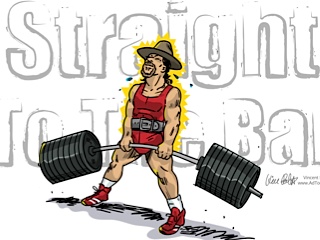
How does one navigate the minefield of conflicting nutritional advice while seeking to improve performance, recovery, body composition or health? My own culinary misadventures have taken me through vegetarianism, veganism, macrobiotics, right on up to born-again-carnivorism. After trying a lot of things, and while continuing my own research and experimentation, I have decided to come up with a list of guidelines that still make sense to me at this point in my travels.
I am not a certified nutritionist. Of course most nutritionists advocate the food pyramid and other absurdities so this may not be a strike against me. The more lay-research I do into nutrition and physical performance and health the more I see vast differences between what the laboratory informed “experts” generally recommend and what those in the trenches practice. For an entertaining and insightful look into the ideology of food guidelines and dietary fads I would recommend hunting down Michael Pollan‘s The Omnivore’s Dilemma at your local library.
Before laying out my haphazard collection of dietary tips I will set out a little scheme as dreamed up by Pollan. I am going from memory here but Pollan sets out the following guideposts, lovely in their simplicity:
- Eat food. That is real food.
- Eat nothing that your grandmother wouldn’t recognize as food.
- Eat nothing with more than 5 ingredients
- Eat less grains, more vegetables and fruit and if we choose to eat meat think of it as a condiment.
I know I don’t have them exactly right but you get the idea. Simple. My quinoa salad from last night breaks rule #3 but I don’t think it applies to homemade food. You get the point. Strikes me as reasonable and not too hard to live by.
Here is my less-lovely list along with short explanations:
Eat less grains. That does not mean to eat no carbs. Try and get your carbs from primarily vegetable and secondarily fruit sources. Think of approaching grains as a condiment. And when you do eat grains try and eat whole grains such as quinoa, amaranth and the like.
Why eat vegetables instead of grains?
- Grains tend to cause spikes in insulin levels which means you will want to eat in order to restabilize insulin, and the choices you make while tryng to restabilize may set the domino effect along even further.
- Vegetables tend to contain many more vitamins and nutrients than than grains. Whatever you eat will contribute to filling you up. If you eat a big helping of grains then you will not likely be eating as many vitamin-rich vegetables or tissue building and tissue repairing proteins.
All fats are not created equal. You must consume healthy fats for your well-being. Much of your brain is lined with fats. Fats promote hormonal communication. So eat avocados, olive oil and flax oil.
- Fish oil: I consider fish oil and protein powder to be a food, not a supplement. The thing with fish oil is that they are not all created equal. Most fish oils, even those readily available at health food stores, are not pure enough to take in the kinds of doses that are deemed most beneficial. High quality pharmaceutical grade fish oils are usually tested batch-by-batch for purity. The oils are usually taken from smaller species of fish which do not tend to bioaccumulate as many toxins. Therefore the potency can be greater without compromising the consumer by exposure to mercury, etc. Fish oils are believed to function as an anti-inflammatory (thereby contributing to heart health, joint health and more), and also may contribute to brain development, eye health, hormonal balance, mood and more.
- Protein shakes: if you are trying to put on muscle mass or maintain a high level of lean muscle mass and recover from intense training it will simply be too difficult to eat real “meals” frequently enough. This is where shakes and protein supplements come in. Many nutritionists dismiss protein powders but if you look at the methods of successful strength athletes you will see that many if not most of them use some kind of protein supplementation.
Eat frequently. The three meals a day model probably came along as an imposition along with the industrialization of the workplace. Just guessing on this one. Aim for 4-6 meals daily. Another reason for shakes.
Eat something within 15 minutes after training. If you are going to eat some simple carbs then this is the best time. There is a magic window post-exercise within which it is best to restore muscle glycogen (contributes to fuelling muscle contraction). Many experts would say this window runs from 14-45 minutes. Get something in, the sooner the better. Mostly carbs with some protein to boot is good. I try to eat within 15 minutes and then again before the 45 minutes window. This will likely help you recover much more quickly from your training bout. Your body will be more well-prepared for the next workout or just for daily life.
If you are trying to put on muscle mass strive to eat minimum 1 gram of protein per pound of bodyweight. Clearly meat/vegetable protein sources will not be a “condiment” in this case.
- 80/20 rule: try and follow your nutritional plan 80% of the time. Cheat the other 20%. It is the 80% that counts and perhaps the opportunities to cheat will help you not go overboard on those days that your willpower disintegrates.
These guidelines should be much simpler to integrate into one’s life than following a strictly delineated eating plan. I advocate a realistic approach to nutrition: start with where you are and introduce small manageable changes over time. Take a gradual and steady approach to lifestyle changes and you are more likely to see a long-lasting improvement.










0 Comments